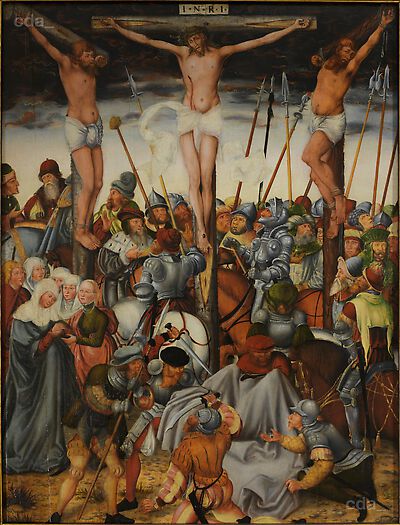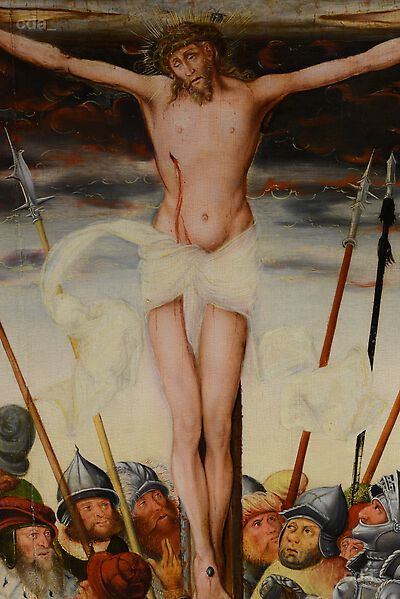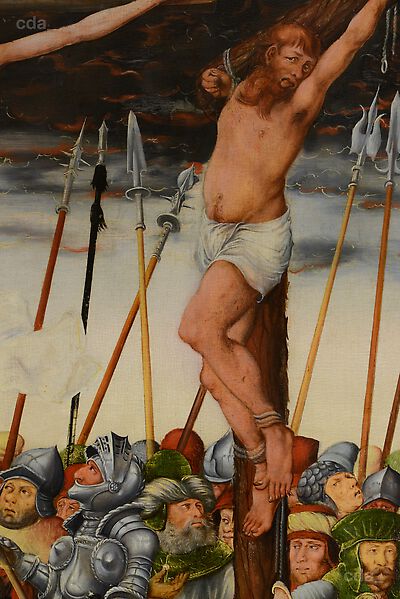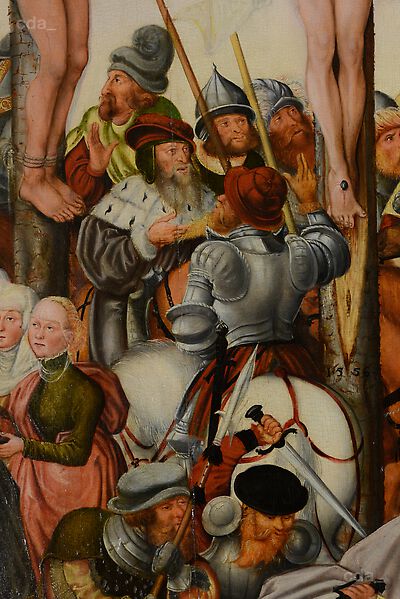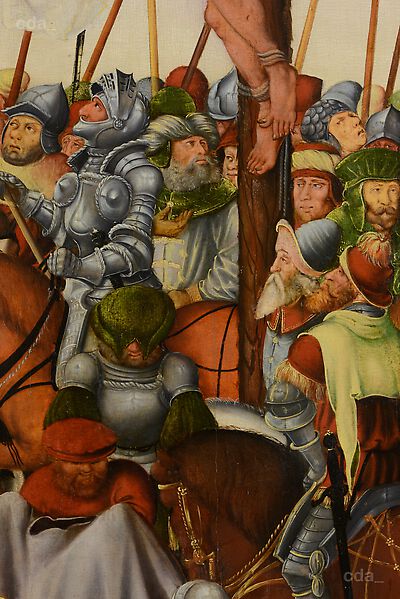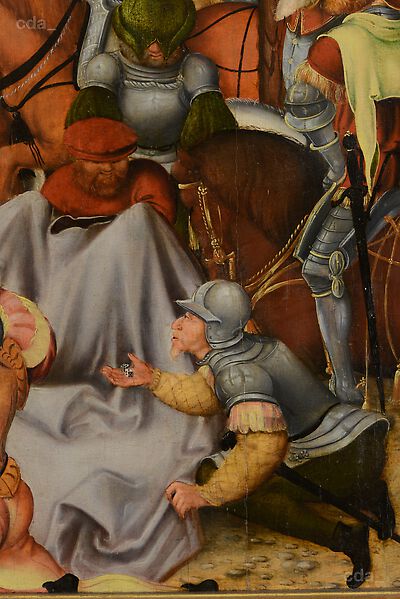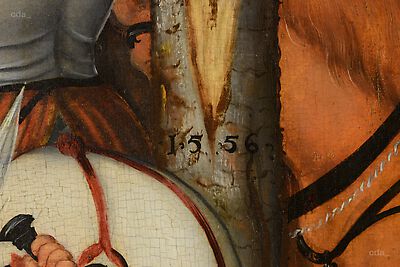Condition Report
Support:
The original support - an oak panel - is no longer in its original state. Before it was cradled it was thinned to a thickness of 5 mm. The original thickness can be estimated at 1-1.5 cm based on the dimensions of the panel.
Both the edges of the panel and occasional exit holes suggest the former existence of woodworm damage, which appears to have compromised the stability of the panel. Judging by the size of the channels and the exit holes it was probably infested with the anobium punctatum beetle.
The visible channels and exit holes on the front of the panel were filled during the last treatment. For this purpose a brown woodfill was employed in areas where the wood was exposed and a chalk/glue fill within the painted area.
During treatment a hairy insect larva of c. 2 mm in length exited the support. Examination under the stereomicroscope enabled it to be classified among the dermestid family. These insects do not feed on wood, however they do nest in wooden material. They are c. 6-16 mm in length and they create entry holes of c. 3-6 mm in diameter.
It may be assumed that this larva is an isolated example as these insects prefer to be near food. However as numerous insects of c. 7-10 mm were found in the church a reason should be found.
The new, auxillary support is 10 mm thick and is made of coniferous wood. A grid cradle was incorporated into this panel to inhibit a potential warping of the panel. The well-known disadvantages of such an intervention - which causes tenting in the paint layers - only occurred to a lesser extent. Therefore at present there is no reason to remove the cradle. However the surface of the painting should be monitored to ensure that large deformations do not develop.
The cradle members are 3.5 cm thick and are made of oak wood. The entire thickness of the panel is 5 cm. It weighs numerous kilos.
The two joins on the left are slightly open (less than 1 mm) along a length of numerous centimetres. Generally the location of the joins are visible due to the typical cracking pattern and show that the planks were aligned vertically, at a slight angle. The original external dimensions of the panel were cropped by c. 10 mm. An assessment of the edges of the panel showed that along the upper and lower edges the wood was left exposed, whereas along the sides the painted surface extends to the edge of the panel suggesting these were trimmed.
Ground:
The ground is in realitively good condition. There is no indication that the adhesion of the binding medium has weakened, or evidence of powdering or delamination. Its adhesion to the support is stable. Occasionally there is a small tendency to flaking along the edge, which requires consolidation.
Underdrawing:
There is no damage to the underdrawing
Paint Layers:
The paint layers are in good condition. There are no large losses. Losses where the ground is exposed are very limited and almost all located along the edges of the joins and the exit holes.
Some of the thinner paint layers and glazes were abraded during a previous cleaning campaign. In this case the thin paint layers were slightly overcleaned where the paint surface stands in relief.
Also resulting from the last conservation treatment are brown, patchy remnants of a gluten glue. These are essentially located at the edge of the painting, but occasionally on the picture plane. They are beneath the varnish layer and are probably remnants of the glue used to consolidate the paint layers and attach the auxillary support.
Numerous small losses have been filled and retouched. The manner and subtlety of this old restoration suggests a high standard of professionalism. It may have been carried out by a local conservator. The retouches have discoloured in some places.
As already implied the cradle caused isolated tenting. This is evident as a rough split within the otherwise homogenous network of aging cracks. To date no flaking has occurred.
In the darker sections of the sky isolated blooming of the medium has occurred. This is the result of microbial exposure or the high relative humidity in the church. However the local light patches are not of such magnitude to warrant regeneration or retouching.
In the cracquelée of some green glazes dark discoloured areas or crusts have developed. This could be a degradation product, like that on the varnish surface. (The saponification of lead white admixtures has caused an increase in the refractive index). The increased transparency of the paint surfaces has made the underdrawing beneath visible to the naked eye as well as various pentimenti. However this is the result of a natural ageing process.
There is a date at the lower third of the shaft of Christ's cross. This is the year in which the panel was created, 1556. An artist's insignia has not been found.
Surface coatings:
The natural resin varnish applied during the last conservation treatment (probably about 1929) among others to protect the paint layers has altered. Significant microbial contamination on the surface (examination under the stereomicroscope showed clear evidence in the cracks) has caused degradation and the formation of dark degradation products along the edges of the cracks, which has left the layer in a fragmentary state. Here it no longer functions as a protective coating.
In addition, but less of a conservation concern, these damaged areas considerably compromise the optical appearance of the image. The varnish layer also exhibits differing degrees of blooming, yellowing (due to an uneven application) and an irregular surface gloss.
The present varnish layers therefore satisfy neither preservation nor aesthetic functions required to justify that they remain. Considering that the relative humidity values where the painting is hanging are high, frequently over 70%, and given the potential for further damage it would seem unprudent to retain them.
Patina:
The dark appearance of the painted surface is caused by a patina consisting of various components, essentially soot, dust and insect dirt. The patches and dark discolourations within the network of cracks are mostly due to the damaged varnish. The layer reacted positively to cleaning tests employing enzymes.
Frame:
The basic structure of the frame is intact. The front and reverse exhibit evidence of woodworm damage ( Anobium punctatum).
The profile members are in part loose and require regluing. The ground and gilding is due to wood shrinkage loose in many places. Here in addition to new losses, old fills and retouchings are visible. The gilding is abraded along the edges of the profile, exposing the red bole.
